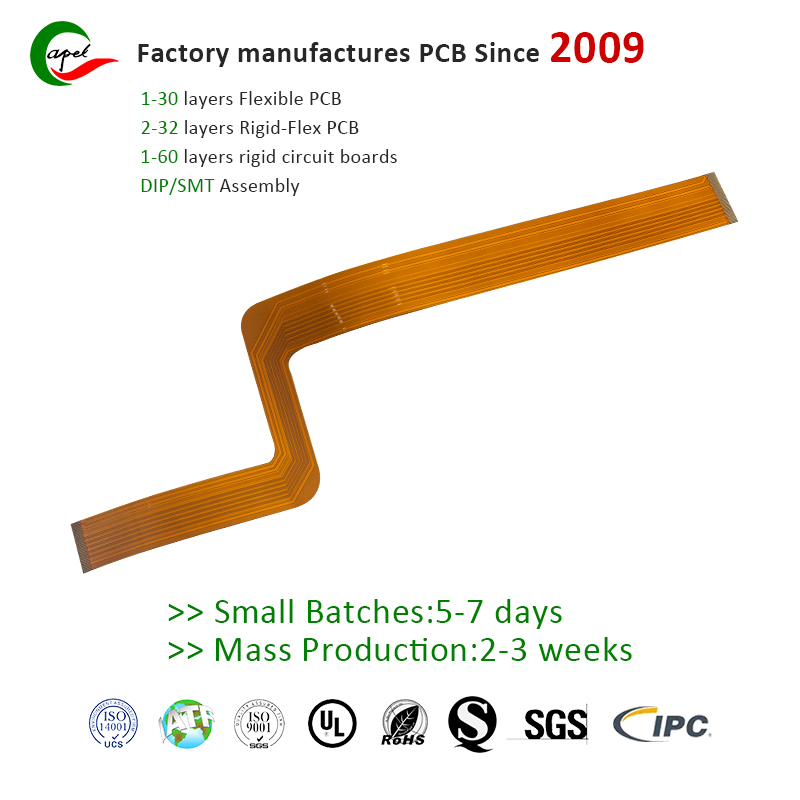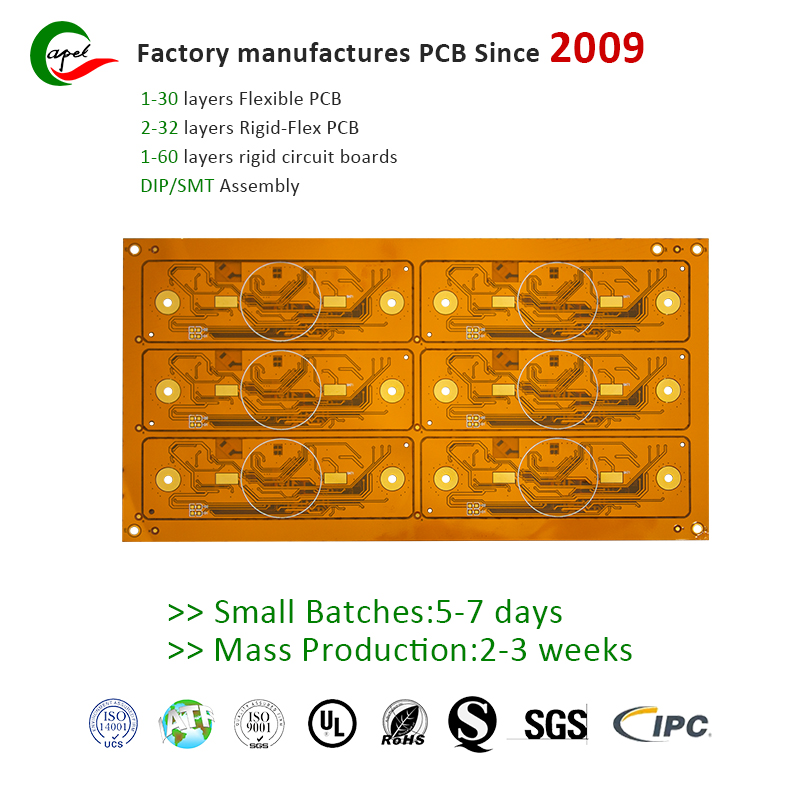Both multi-layer flexible PCBs and single-layer flexible circuits are key components in modern electronic devices. Their flexibility and durability enable them to be used in a wide range of applications. However, when it comes to reliability, users often ponder which option is the better investment. In this article, we’ll delve into the characteristics, advantages, and disadvantages of multilayer flex PCBs and single-layer flex circuits to determine which technology offers higher reliability.
1.Understanding multilayer flexible PCB:
Multilayer flexible printed circuit boards (PCBs) are gaining popularity in the electronics industry due to their numerous advantages over traditional single-layer flex circuits. Multilayer flexible PCBs consist of three or more layers of flexible materials, such as polyimide or polytetrafluoroethylene (PTFE), bonded together using adhesive materials. These layers are then interconnected with conductive tracks, allowing electrical signals to be transmitted between components.
One of the main advantages of multilayer flex PCBs is the improved signal integrity they provide. Additional layers help reduce the possibility of electromagnetic interference (EMI) and crosstalk, which can degrade the quality of the transmitted electrical signal. This is especially important for high-speed and sensitive applications where clear and accurate signal transmission is critical.
The design flexibility of multilayer flex PCBs is another significant advantage. By introducing multiple layers, designers have more options to optimize circuit layout, reduce overall size and increase the functionality of electronic devices. This allows for greater creativity and innovation in the design process, resulting in more efficient and compact equipment.
In addition, multi-layer flexible PCB can also increase component density. With additional wiring layers, a higher number of components can be integrated on the board. This is especially beneficial for devices that require complex functions in a limited space. By making efficient use of the available layers, designers can create compact electronic devices capable of performing multiple functions.
In addition to these benefits, multilayer flexible PCBs offer other benefits such as improved durability, flexibility, and resistance to environmental factors. The material’s flexibility allows for bending and folding, making it suitable for applications where space is limited or devices need to conform to a specific shape or contour. The durability of multilayer flexible printed circuit boards is enhanced by multiple layers that distribute stress and reduce the risk of fatigue and cracking. Additionally, these PCBs are more resistant to moisture, solvents, and other external factors that can impair circuit functionality.
It’s worth noting, however, that multilayer flex PCBs do have some drawbacks. The complexity of the design process and manufacturing techniques can add to the overall cost compared to single-layer flex circuits. Also, the production process may require more time and specialized equipment. These factors should be considered when deciding whether to use a multilayer flex PCB for a particular application.
2.Examining Single Layer Flex Circuits:
Single-layer flex circuits, as the name suggests, consist of just one layer of flexible material, usually polyimide or polyester, laminated with a thin pattern of copper traces. Unlike multilayer flex PCBs, which have multiple layers bonded together, single-layer flex circuits offer simplicity and cost-effectiveness, making them suitable for applications requiring basic functionality.
One of the main advantages of single-layer flex circuits is their simplicity. A single-layer design means that the manufacturing process is relatively simple and less time-consuming than multilayer circuits. This simplicity also translates into cost-effectiveness, as the materials and processes involved in producing single-layer flex circuits are generally less expensive than multilayer flex circuits. This makes single-layer flex ideal for low-end products or cost-conscious applications.
Despite their simplicity, single-layer flex circuits still offer a large degree of flexibility. The flexible material used in its structure can bend, fold and adapt to different shapes. This flexibility is especially valuable for applications that require integrating circuits into tight spaces, curved surfaces, or irregular shapes. Single-layer flexible circuits can be easily bent or folded without compromising their functionality, making them suitable for a wide range of applications.
Another benefit of single-layer flex circuits is their reliability. Utilizing a single layer of flex material and copper traces minimizes the risk of interconnect failures such as cracks or breaks. The absence of multiple layers reduces the possibility of delamination or problems caused by differences in the coefficient of thermal expansion (CTE) between layers. This enhanced reliability makes single-layer flexible circuits suitable for applications where circuits need to withstand repeated bending or folding, such as portable devices, wearable technology or automotive electronics.
Single-layer flex circuits can also improve signal integrity compared to traditional wiring harnesses. Using copper traces on a flexible substrate provides better conductivity and lower resistance than wiring harnesses made from multiple discrete wires. This reduces signal loss, improves transmission efficiency, and reduces electromagnetic interference (EMI) problems. These factors make single-layer flex circuits suitable for applications where signal integrity is critical, such as high-frequency communication systems or audio-visual equipment.
Despite these advantages, single-layer flex circuits have some limitations. They may not be suitable for applications requiring complex functionality or high component density. Single-layer designs limit the number of components that can be integrated onto a circuit, while the lack of multiple layers limits routing options and can make implementing complex circuit designs challenging. Additionally, single-layer flex circuits may have limitations in impedance control and longer signal paths, which may affect signal quality in high-speed applications.
3.Reliability Comparison:
Flex and stress points play a vital role in the reliability of multi-layer flex PCBs and single-layer flex circuits. Both designs are flexible, allowing them to bend and adapt to various shapes. However, multilayer flex PCBs tend to be more resistant to fatigue and stress-induced cracking. The multilayer structure in a multilayer flexible PCB can distribute stress more effectively, thereby reducing the risk of failure under bending and twisting conditions. This enhanced resistance to stress makes multilayer flexible PCBs more reliable in applications that require repeated bending or folding.
In terms of environmental durability, both multi-layer flexible PCBs and single-layer flexible circuits can provide reliable performance depending on the application and environmental conditions. However, multilayer flex PCBs generally offer better protection from moisture, solvents, and other external factors that can impair circuit functionality. The multiple layers in a multilayer flexible PCB act as a barrier to these components, preventing damage and ensuring circuit reliability. This makes multilayer flexible PCBs more suitable for applications that may be exposed to harsh environmental conditions.
Redundancy and fault tolerance are important considerations when evaluating the reliability of flex circuits. Multilayer PCBs inherently provide redundancy and fault tolerance due to their multiple layers. If a single layer in a multi-layer flexible PCB fails, the remaining functional layers can still maintain the overall function of the circuit. This redundancy ensures that the system continues to operate even if some layers are compromised. In contrast, single-layer flex circuits lack this redundancy and are more susceptible to catastrophic failure if critical connections are severed. The lack of a support layer makes single-layer flex circuits less reliable in terms of fault tolerance.
Multi-layer flexible PCBs and single-layer flexible circuits have their own advantages and disadvantages in terms of reliability. The multi-layer structure of the flexible printed circuit board enhances the resistance to fatigue and stress-induced cracking, making it more reliable under bending and twisting conditions. Multilayer flex PCBs also provide better protection from moisture, solvents, and other environmental elements. Additionally, they exhibit improved signal integrity and provide redundancy and fault tolerance. On the other hand, single-layer flex circuits are simpler and more cost-effective, making them suitable for applications that require basic functionality and cost-efficiency. However, they may lack the reliability offered by multilayer flexible PCBs, especially in terms of stress resistance, environmental durability, and fault tolerance.
In Conclusion:
While both multi-layer flex PCBs and single-layer flex circuits have their place in the electronics industry, multi-layer flex PCBs have proven to be more reliable in terms of flexibility, pressure resistance, environmental durability, signal integrity, and fault tolerance. Single-layer flex circuits are cost-effective and suitable for simple applications, but when reliability is the primary concern, multi-layer flex PCBs come to the fore. Consider specific design requirements, environmental conditions and performance goals when selecting the most reliable option for your electronic equipment.Shenzhen Capel Technology Co., Ltd. has been manufacturing flexible printed circuit boards (PCBs) since 2009. Currently, we are able to provide custom 1-30 layer flexible printed circuit boards. Our HDI (High Density Interconnect) flexible PCB manufacturing technology is very mature. Over the past 15 years, we have continuously innovated technology and accumulated rich experience in solving project-related problems for customers.
Post time: Sep-01-2023
Back









